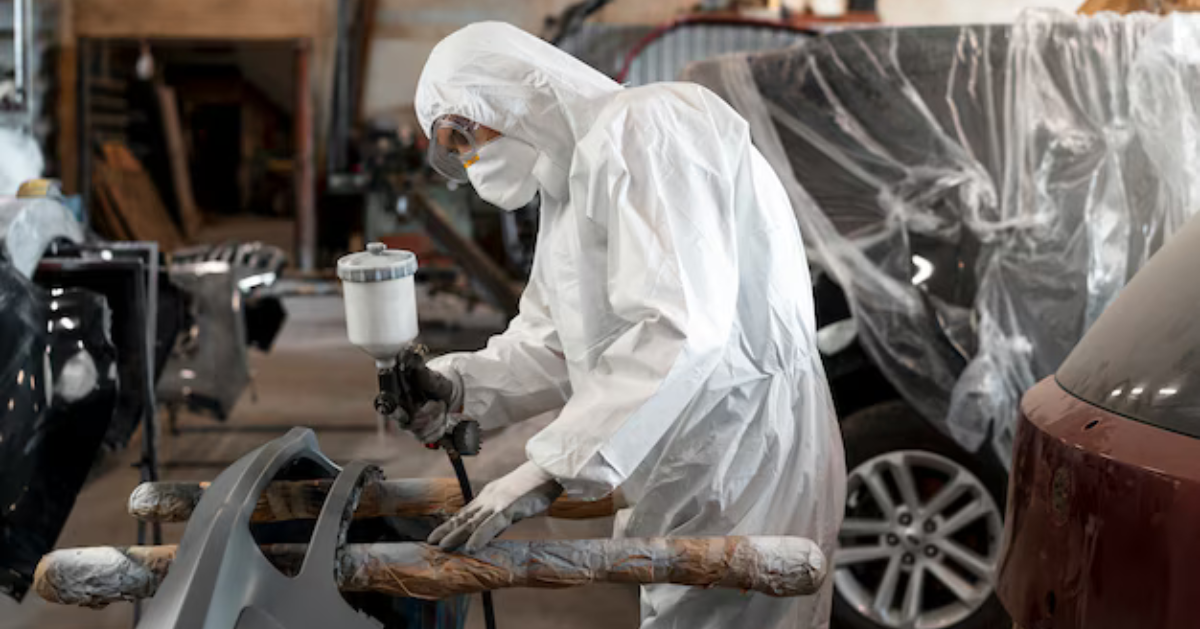My studio is in Gothenburg in Sweden. It’s located in an industrial area not far from the sea. From my window, I can see some old boats and the bridge which leads to the city center on the other side.My studio is a composition of works in progress that are laying around everywhere. There are some old pieces of installations hanging from the window, always a couple of paintings that are work in progress stapled onto the walls.There are also some study works and things that I have found. At the moment there are a lot of different textiles with various patterns and colours. But basically, it is a mess.Can you describe how you go about starting a painting or series? What sparks you to create?
Starting a painting is for me always very impulsive. Sometimes I strongly feel the need to start laying down on a canvas a particular story or idea I have in mind. Some other times, I have no idea what to create. I just literally want to paint and play around with the material. In losing myself in the process, things appear. I cannot help it but see the blank canvas as a depositary of unburdening. What sparks me to create I would say is a blend between my own sensations, personal experiences and the need to understand the complexities of the act of painting. Making a painting is like a mathematical equation that needs to be solved. Between colours, shapes, textures, dimension, storytelling, I am always trying to juggle between all these elements and find the thin line between abstraction and representation. All together these elements need to work out.How did you find your way to becoming an artist? When did you really feel like that was what you wanted to be and that you were going to make it happen?
I think it has always been within me but it took me a long time before taking the step of saying: ”Ok. This is who I am and what I breathe for.” I guess certain events of my life which were hard to overcome made me strongly believe that art was a need in order for me to feel good. This is when I realised it was where I belong. I will never be disappointed by art and the process of creating and making. It brings a certain feeling of joy that I haven´t found anywhere else. The solitude of being an artist can be difficult but the quest of the self and the results that emane from them, I found truly beautiful.
What I love about your work is how light and free it is. I suppose I admire a lot of abstract work because I imagine the artist freely moving around the painting and having a lot of fun. But me, I’m so tight in my representational work and all the gestures are very controlled. What advice would you give to someone like me, someone who has a bit of trouble letting go?
It’s difficult to say. Perhaps thinking ”what if” instead of ”I must”. It is important to open possibilities within the act of painting itself instead of contriving it from the beginning. I am a strong believer that great outcomes only pops up from mistakes and taking risks. If the difficulty is to lose yourself, perhaps you can already start creating from an abstracted drawing and breaking the representational lines.
\What are some of the myths you refer to in your work? And what real-world political narratives? Could you share a specific example present in one of your pieces?
Iliad and the odyssey quite often comes back in my work. It was the theme of a previous series of paintings I made called ”Le coeur pur”. These myths can be real or imagined which I like the most because I can incorporate some fantasies of my own. I am aiming at creating my personal mythology whereby I juxtapose elements taken from my surroundings and the domestic every day life to symbols that I have caught my eyes and jumbled them all together. At least, that´s what I´m trying to do. I am genuinely fascinated by relationships of all kinds and how humans interact with their natural environment. The myths I refer to always seem to question the complexities of the human heart. The series of painting including ”The little doll rescue”, ”Defiance” and ”Love in the microscope”
One of my latest painting called ”Emperor” directly refers to the feminine Oedipus complex. Since I have moved to Sweden, I have been interested by the questions of gender and identities, trying to identify what defines masculinity and femininity. Here, I explore dramatic imposing male figures interacting with their female surroundings in various context. In this painting in particular, I wanted to explore the dynamics between a daughter and her father and the elements of sexuality that can arise. Ironically The figure which is laying down on the floor is ”twerking” behind the seat where her father is sitting. In this piece I am also referring to the 17th century merchants collar I recently got obsessed with and got striked with during my last visit at the National portrait gallery in London. I like the somehow ridiculous look of this collar somewhere in between buffoonery and pompous. I have used it in other pieces including ”The veteran and the queen” and ”Politician”.
I recently came across a short news video showing British war veterans gathering at the gates of Downing Street to protest against the UK operations in Syria. They were all standing in a small group and symbolically threw down their war medals on the pavement. I found this image extremely powerful and wanted to use it in my work.
That same week, I also came across Zendra Rhodes’s wonderful textile designs.
I have always been working on my own iconography but I have intentionally started ”The veteran and the queen” as a first piece for me to insert my own symbolic through the use of patterns. Pride, solitude and hierarchies within relationships seem to come back as recurrent obsessions.
Rothko said it all in his book The Artist’s Reality: ”The cult of materialism, which has been adopted in one way or another in many parts of the world is a substantial basis for the evolution of symbols which could bring to life, in terms of pictorial symbols, human interaction in relation to its new myth. ”
I think that Sweden really strives to achieve gender equality which naturally brings all sorts of discussions around what genders are, what defines them and what is the nomenclatura behind them. The natural desire of humans to put other living species including themselves into boxes is very interesting and is questioned here more than anywhere else I have been to. I think that there is a strong sense of tolerance amongst most people here which I admire. On the other hand it can also lead to what I would perhaps call an over tolerance where boundaries become very blurry; A dictatorship of the ”good thinking”.
I don´t really like any kind of ideology, of any form. In pursuing any kind of strict political vision, I think that humans are creating other forms of intellectual restrictions. Ideology makes people stop questioning and that can be dangerous. Can you imagine a 21st century art driven by ideology? It wouldn´t be art at all….
I think I literally woke up one day and thought that I should buy lots of tights and fill them up with stuff. Perhaps already being very interested by the body, the flesh, and the anatomy in general I wanted to start creating my own human. I think painting felt a bit like a closed door at the time so going into 3D works was I think a continuity of my previous work. My way of painting started to evolve into more juxtaposition of intricate layers, blending into one another. I think that creating 3D works help me visualise what I can do in 2D. And, it’s a lot of fun!
I think my work is becoming more cohesive and I can see all sorts of things I have tried over the years coming along together into one united voice. I am happy about that. I also think there is a strong feeling of textile which is developing. I love textiles, I love painted textile, I love fabric and patterns but I don’t really like sawing. It´s too repetitive. So I think I’m going to try to weave the paint and perhaps even integrate fabrics into the paintings. I don’t know how yet…Let’s see how it comes out. I am trying out some things these days; pure studies of textiles on canvas.










